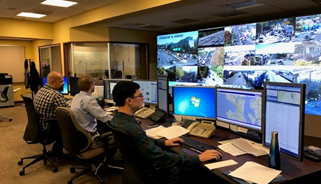SMART CITY, TOLL SYSTEM, TRAFFIC & LAW ENFORCEMENT

REVOLUTION ON TRAFFIC ENFORCEMENT TECHNOLOGY
In 2006, the field of traffic enforcement technology witnessed a revolution with the introduction of VITRONIC LIDAR systems (Light Detection and Ranging). Suddenly, it was possible to clearly and accurately detect multiple vehicles across several lanes in both directions at the same time even in dense traffic and with just one system – fully automatically, without sensors in the road surface.
Today, the POLISCAN – VITRONIC systems in their striking pillars have become an integral part of traffic enforcement processes worldwide and have largely replaced the conventional, technically limited measurement technologies such as radar.
Around the world, several thousand VITRONIC laser scanners with their high-precision and reliable measurement technology and a high degree of flexibility ensure improved traffic safety and more efficient traffic monitoring.
The LIDAR Technology
» Monitors speed, red light, lane-related and tailgating violations
» Measures all vehicles on several lanes
» Accurately assigns offenses to vehicles even in heavy traffic
» Works fully automatically
» Distinguishes between different vehicle classes
» Records significantly more infringements than radar
Today, governments around the world are prioritizing improving road safety. Speed enforcement is a highly trusted tool to curb road user behavior in traffic law enforcement.
I. TRAFFIC & SPEED ENFORCEMENT SYSTEMS
Task
Long stretches of road or tunnels are often an invitation to speed over the entire distance. To increase traffic safety on entire road sections, speeds have to be monitored not only at one particular point but along the danger zone.
Solution
Full speed enforcement along road sections is possible with average speed enforcement. With POLISCAN SECO the average speed driven between two or more measurement points (point-to-point) is determined by using automatic number plate recognition to record vehicles when they enter and exit the section of road. If the average speed exceeds the permitted value, the system documents the violation.
» Continuous speed enforcement on long or dangerous road sections
» Improved traffic flow
» Supports traffic management when combined with variable message signs
» Can be combined with other ANPR applications
II. RED – LIGHT SPEED ENFORCEMENT
RED – LIGHT SPEED ENFORCEMENT
Task
Intersections are black spots and their monitoring is important. Conventional red light enforcement, however, requires induction loops or piezoelectric sensors in the area of the stop lines. Their installation and maintenance are costly, result in traffic congestion, and have a limited service life.
Solution
POLISCAN REDLIGHT is able to monitor multiple lanes and multiple vehicles. Through continuous LIDAR position determination, the system detects and documents all red-light violations on intersections. POLISCAN RED+SPEED additionally documents speed violations during all traffic light phases. Optional remote cameras record images or
» No in-road sensors required
» Simultaneous monitoring of red light and speed violations
» Monitoring of one or two driving directions
» Secondary video evidence

III. AVERAGE SPEED ENFORCEMENT FOR A SAFER TRAFFIC FLOW

POLISCAN Seco can be used in fixed, semi-stationary, and mobile applications. It can monitor adherence to speed limits specific to lanes and vehicle classes.
With section control systems, you ensure comprehensive speed calming. They enable more efficient monitoring of tunnels, inclines, highways, and construction sites in particular. This applies to both simple road sections and intersections. Unauthorized use of road sections and unsafe passing can also be monitored and number plates read automatically.
As section control is vehicle-based, it can also be combined with toll applications. The systems can be operated from bridges or from the roadside. With the roadside operation, fixed-checkpoint speed enforcement is also possible at entry and exit points.
Autonomous Enforcement: Trailer
The ENFORCEMENT TRAILER enables long-term or permanent automated speed enforcement at accident hotspots that lack the infrastructure required for a fixed speed camera.
» Minimum five days of 24-hour operation
» Built-in modem for wireless data transmission case and remote access
» Protected against vandalism with bullet-proof exterior and alarm system

VI. REMOTE MONITORING OF TRAFFIC ENFORCEMENT SYSTEMS
Automatic management enforcement process of violations whether speed violations, red lights, or other types of system, are truly effective only if the offender sees a direct correlation between the violations committed, the evidence of the violation, and the payment of the fine. This relationship is most obvious when the system is operational 24/7 and the time between breach and notification is kept as short as possible.

REMOTE SYSTEM MONITORING OF TRAFFIC ENFORCEMENT SYSTEMS
Efficient and Convenient
Digitalization saves resources and simplifies work processes. With remote control of traffic technology, you benefit from much faster information retrieval from remote enforcement units. This means it’s no longer necessary to travel to these units, so personnel costs are reduced. Monitoring and control are performed online from a central location.


Traffic Management with Real-Time Data
Digitalization and IT networking form the backbone of many smart city concepts. Their development would not be feasible or useful without networked data acquisition. With the use of centralized system monitoring further real-time data can be generated in the future. This data can then be used to directly implement any necessary traffic management measures. These include, for example, traffic control to reduce congestion and protect the environment.
